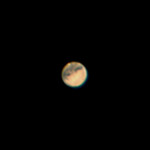Mars is the fourth planet from the Sun and the second-smallest planet in the Solar System, larger only than Mercury. Mars is named for the Roman god of war. Mars is a terrestrial planet with a thin atmosphere and has a crust primarily composed of elements similar to Earth’s crust, as well as a core made of iron and nickel. Mars has surface features such as impact craters, valleys, dunes, and polar ice caps. Mars has two small, irregularly shaped moons, Phobos and Deimos.
Days and seasons on Mars are comparable to those of Earth, as the planets have a similar rotation period and tilt of the rotational axis relative to the ecliptic plane. Liquid water on the surface of Mars cannot exist due to low atmospheric pressure, which is less than 1% of the atmospheric pressure on Earth. Both of Mars’s polar ice caps appear to be made largely of water. In the distant past, Mars was likely wetter, and thus possibly more suited for life.

